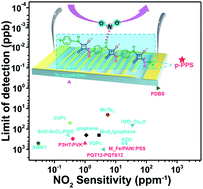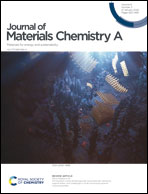An ion-in-conjugation polymer enables the detection of NO2 with parts-per-trillion sensitivity and ultrahigh selectivity†
Abstract
The detection of nitric dioxide (NO2) at the parts-per-trillion (ppt) level is critical for both environmental monitoring and human health. However, none of the chemiresistors reported to date can detect NO2 at the parts-per-trillion (ppt) level due to the low sensitivity of the sensory materials. In this work, an ion-in-conjugation polymer para-polyphenylsquaraine (p-PPS) was designed and fabricated into an NO2 chemiresistor. The sensor had the highest sensitivity of 1450 ppm−1 (at 100 ppb) and the lowest detection limit of 40 ppt among all reported chemiresistors. In addition, p-PPS showed ultrahigh selectivity, where other interfering gases had less than 1/1887th of the signal of NO2 under the same concentration (10 ppm). Calculations, in situ infrared spectroscopy and sum frequency generation spectroscopy (SFG) revealed that the ion-in-conjugation-inspired H-bonding between p-PPS and NO2 led to such high sensitivity. Our results highlight the potential of the concept of ion-in-conjugation in the design of highly sensitive gas sensory materials.



 Please wait while we load your content...
Please wait while we load your content...